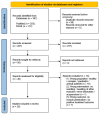Intramuscular Injections and Dry Needling within Masticatory Muscles in Management of Myofascial Pain. Systematic Review of Clinical Trials
- PMID: 34574476
- PMCID: PMC8465617
- DOI: 10.3390/ijerph18189552
Intramuscular Injections and Dry Needling within Masticatory Muscles in Management of Myofascial Pain. Systematic Review of Clinical Trials
Abstract
Background: Myofascial pain is an important cause of disability among the whole population, and it is a common symptom of temporomandibular joint disorders (TMDs). Its management techniques vary widely; however, in recent years, there has been a growing interest especially in needling therapies within masticatory muscles, due to their simplicity and effectiveness in pain reduction.
Methods: The construction of the following study is based on PICOS and PRISMA protocols. A systematic literature search was conducted based on the PubMed and BASE search engines. Searching the abovementioned databases yielded a total of 367 articles. The screening procedure and analysis of full texts resulted in the inclusion of 28 articles for detailed analysis.
Results: According to analyzed data, clinicians manage myofascial pain either with wet or dry needling therapies. The most thoroughly studied approach that prevails significantly within the clinical trials is injecting the botulinum toxin into the masseter and temporalis. Other common methods are the application of local anesthetics or dry needling; however, we notice the introduction of entirely new substances, such as platelet-rich plasma or collagen. In the analyzed articles, the target muscles for the needling therapies are most commonly localized by manual palpation although there are a variety of navigational support systems described: EMG, MRI or EIP electrotherapy equipment, which often aid the access to located deeper lateral and medial pterygoid muscle.
Conclusions: Needling therapies within masticatory muscles provide satisfactory effects while being simple, safe and accessible procedures although there still is a need for high quality clinical trials investigating especially injections of non-Botox substances and needling within lateral and medial pterygoid muscles.
Keywords: Botox; dry needling; intramuscular injections; myofascial pain; temporomandibular disorders; wet needling.
Conflict of interest statement
The authors declare no conflict of interest.
Figures




Similar articles
-
Needling therapies in the management of myofascial pain of the masticatory muscles: A network meta-analysis of randomised clinical trials.J Oral Rehabil. 2020 Jul;47(7):910-922. doi: 10.1111/joor.12960. Epub 2020 Apr 22. J Oral Rehabil. 2020. PMID: 32159870 Review.
-
The effectiveness of the masseteric nerve block compared with trigger point injections and dry needling in myofascial pain.Cranio. 2023 Mar;41(2):96-101. doi: 10.1080/08869634.2020.1820686. Epub 2020 Sep 16. Cranio. 2023. PMID: 32935643
-
Effectiveness of dry needling on the local pressure pain threshold in patients with masticatory myofascial pain. Systematic review and preliminary clinical trial.Cranio. 2021 Mar;39(2):171-179. doi: 10.1080/08869634.2019.1588518. Epub 2019 Mar 27. Cranio. 2021. PMID: 30916621
-
A systematic review of different substance injection and dry needling for treatment of temporomandibular myofascial pain.Int J Oral Maxillofac Surg. 2018 Nov;47(11):1420-1432. doi: 10.1016/j.ijom.2018.05.003. Epub 2018 May 23. Int J Oral Maxillofac Surg. 2018. PMID: 29801994
-
Efficacy of dry needling in patients with myofascial temporomandibular disorders related to the masseter muscle.Cranio. 2020 Sep;38(5):305-311. doi: 10.1080/08869634.2018.1526848. Epub 2018 Oct 9. Cranio. 2020. PMID: 30296920 Clinical Trial.
Cited by
-
Repeated Intra-Articular Administration of Platelet-Rich Plasma (PRP) in Temporomandibular Disorders: A Clinical Case Series.J Clin Med. 2022 Jul 22;11(15):4281. doi: 10.3390/jcm11154281. J Clin Med. 2022. PMID: 35893369 Free PMC article.
-
Autologous Blood Injections in Temporomandibular Hypermobility: A Systematic Review.J Clin Med. 2023 Aug 27;12(17):5590. doi: 10.3390/jcm12175590. J Clin Med. 2023. PMID: 37685657 Free PMC article. Review.
-
Injectable Platelet-Rich Fibrin (I-PRF) Administered to Temporomandibular Joint Cavities: A Scoping Review.J Clin Med. 2023 May 7;12(9):3326. doi: 10.3390/jcm12093326. J Clin Med. 2023. PMID: 37176766 Free PMC article.
-
Complicated Relationships between Anterior and Condylar Guidance and Their Clinical Implications-Comparison by Cone Beam Computed Tomography and Electronic Axiography-An Observational Cohort Cross-Sectional Study.Life (Basel). 2023 Jan 26;13(2):335. doi: 10.3390/life13020335. Life (Basel). 2023. PMID: 36836692 Free PMC article.
-
Treatment of Mandibular Hypomobility by Injections into the Temporomandibular Joints: A Systematic Review of the Substances Used.J Clin Med. 2022 Apr 20;11(9):2305. doi: 10.3390/jcm11092305. J Clin Med. 2022. PMID: 35566431 Free PMC article. Review.
References
-
- Weller J.L., Comeau D., Otis J.A.D. Myofascial Pain. Semin. Neurol. 2018;38:640–643. - PubMed
-
- Deregibus A., Ferrillo M., Grazia Piancino M., Chiara Domini M., de Sire A., Castroflorio T. Are occlusal splints effective in reducing myofascial pain in patients with muscle-related temporomandibular disorders? A randomized-controlled trial. Turk. J. Phys. Med. Rehabil. 2021;67:32–40. doi: 10.5606/tftrd.2021.6615. - DOI - PMC - PubMed
-
- Schiffman E., Ohrbach R., Truelove E., Look J., Anderson G., Goulet J.P., List T., Svensson P., Gonzalez Y., Lobbezoo F., et al. Diagnostic Criteria for Temporomandibular Disorders (DC/TMD) for Clinical and Research Applications: Recommendations of the International RDC/TMD Consortium Network* and Orofacial Pain Special Interest Group†. J. Oral Facial Pain Headache. 2014;28:6–27. doi: 10.11607/jop.1151. - DOI - PMC - PubMed
Publication types
MeSH terms
LinkOut - more resources
Full Text Sources

